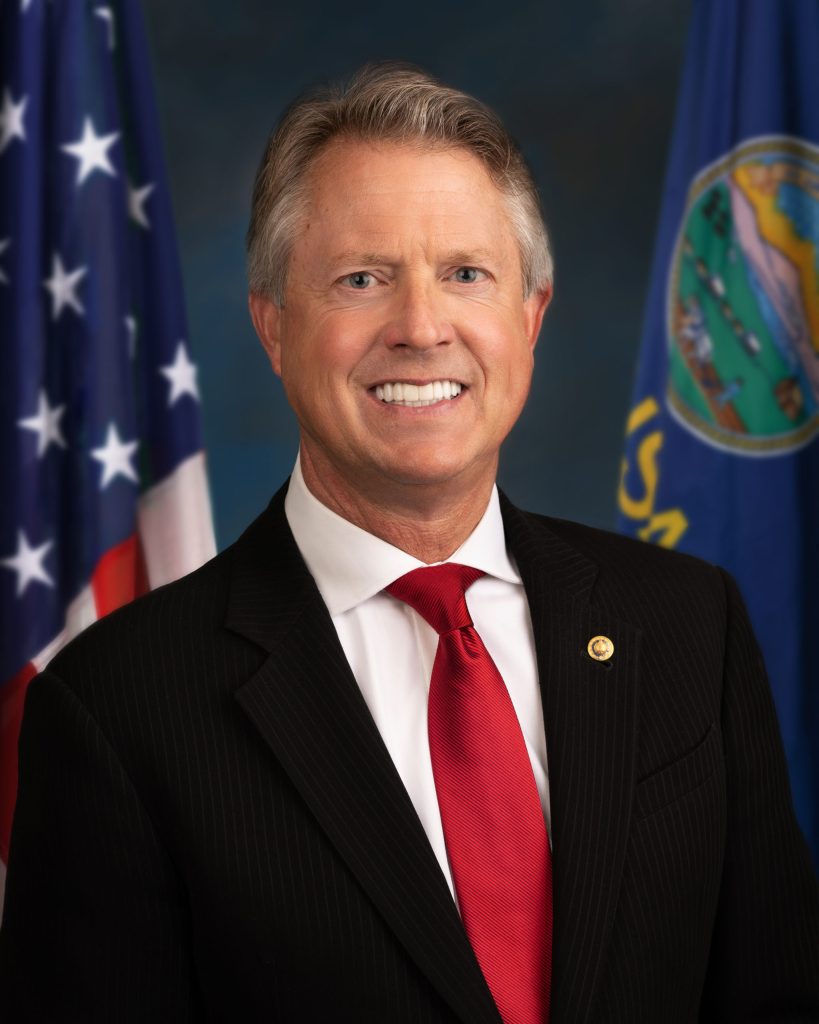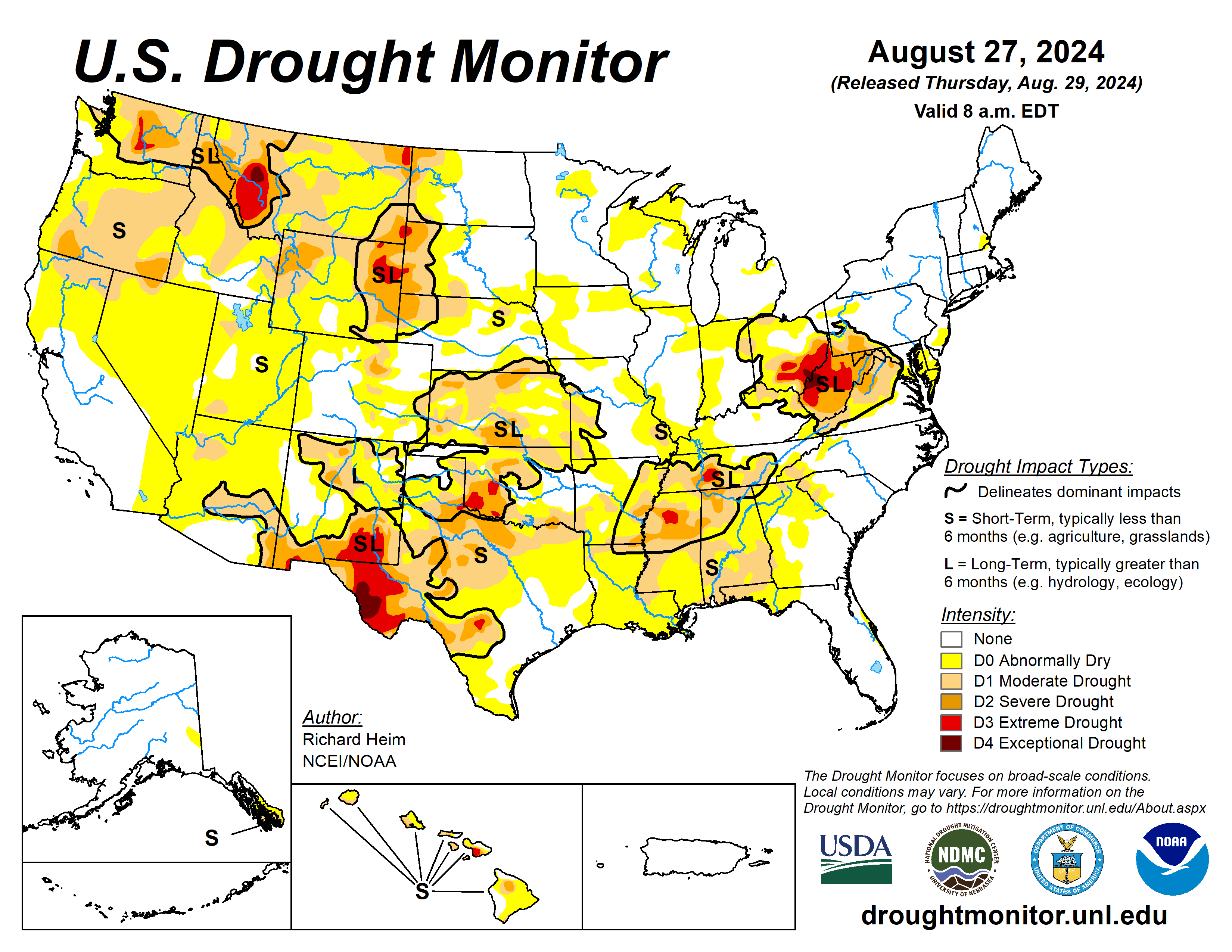U.S. Sens. Roger Marshall, and Michael Bennet sent a letter urging Secretary of Agriculture Tom Vilsack to adapt the U.S. Department of Agriculture’s drought mitigation programs to provide sufficient resources to western farmers and ranchers.
The letter details testimony and recommendations given by Colorado and Kansas producers, water experts and state officials from the June field hearing in Burlington, Colorado. The field hearing, titled Hearing on the High Plains: Combating Drought with Innovation, focused on solving the unique challenges historic drought is creating for western producers. Both are members of the Senate Agriculture Committee.
Pictured above is the latest drought map issued Aug. 29 courtesy of the The U.S. Drought Monitor is jointly produced by the National Drought Mitigation Center at the University of Nebraska-Lincoln, the U.S. Department of Agriculture and the National Oceanic Atmospheric Administration. (The map is furnished by NDMC.)
“Through our field hearings and testimonies, we heard the problems and complications loud and clear. It’s now time to focus on solutions,”said Marshall, a Kansas Republican. “We hope the USDA will take the next steps and make improvements and investments to help our Kansas and Colorado producers. We recognize that these won’t solve all our water issues in the West, but it’s a good start.”

“Colorado and Kansas producers told us they cannot survive the current levels of drought unless we make serious changes to how we address it,” said Bennet, a Colorado Democrat. “Their field hearing testimonies were invaluable, and now we need the assistance from our USDA programs and upcoming Farm Bill to reflect the unique challenges they are facing.”
The letter specifically addresses multiple USDA programs that could be improved, including the Conservation Reserve Program, Conservation Reserve Enhancement Program, Environmental Quality Incentives Program and Watershed and Flood Prevention Program (PL-566). In addition, the letter recommends increased investment in water conservation research and the scaling of innovative and voluntary water conservation approaches, like the creation of a voluntary groundwater conservation pilot program mirrored after Bennet’s Voluntary Groundwater Conservation Act.
In their letter, they noted that current CRP rental rates are largely based on soil productivity and should instead be based on erodibility indexes. The current financial compensation structure leads to enrollment of the more productive soils and provides little or no incentive for those who have poorer soils to enroll, they said. Additionally, producers would like to see the overall annual payment cap increased to at least $125,000 per individual or entity.
Within CRP, the Conservation Reserve Enhancement Program has been used to address water conservation efforts. However, both states are facing headwind, they wrote.
- The Republican River Water Conservation District dryland-farmable CREP was not effective, they said. Last year, the RRWCD’s entered into the nation’s first dryland-farmable CREP agreement with the State of Colorado and the Farm Service Agency. Unfortunately, no applications have been received by the local FSA due to administrative restrictions or contradictory requirements in the agreement. Restrictions included the requirement to plant cover crops the first year of production and to implement a rigid crop rotation in which cover crops must be produced as much as 30% of the 14 to 15 contract years. Also, producers must apply up to half an acre foot of water in the first year of their contract to establish wildlife habitat surrounding the 130-acre crop circle. This allows a producer to use almost 95.5% of the 65 acre-feet of the water applied to the entire crop circle, when in fact they believe the objective of the contract is to conserve the Ogallala Aquifer.
- They also referenced the The Rio Grande Water Conservation District CREP. This agreement has struggled to enroll acres for multiple reasons, including that the agency has historically discouraged alfalfa as an eligible crop. Continuous cropping alfalfa fields need to be made directly eligible for participation in this program, they said. Another deficiency was inadequately designed revegetation programs that do not meet the actual circumstances existing on the ground, they said. The agency should increase the number of years where limited irrigation could occur and allow for more water to be applied than is currently permitted. Only with a right to apply more water over a longer period of time is there a realistic opportunity to ensure that a permanent natural cover can be created on land that has often been disturbed and managed as irrigated farm ground for close to 100 years, they said. Greater flexibility was needed to choose the type of cover crop to be used in highly unique growing environments, like the San Luis Valley. Choosing seed mix that is predominantly gathered from the local species should be encouraged to increase the chance of a successful revegetation and increase producer confidence in the program.
- The proposed Rattlesnake Creek Basin Dryland CREP appeared to be stalled with Farm Service Agency staff at headquarters.
The senators also asked the USDA to implement the EQIP water management entity provision that allowed the Natural Resources Conservation Service to enter contracts with entities such as irrigation districts, ditch companies and groundwater management districts to implement voluntary regional-scale water conservation and efficiency improvements. Despite this authorization, NRCS has not widely utilized this new authority within western states, partly due to limited NRCS guidance on how best to implement these provisions in line with the statute and limited financial and technical resources.
The NRCS has the ability to address aging water infrastructure challenges through the PL-566 program, but the program needs updating to address unique challenges, they said.
They also called on USDA to consider greater flexibility for voluntary conservation programs because they believed that is the best practice for farmers and ranchers.




